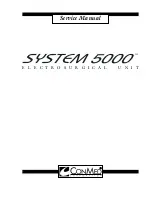
3-5
sary for electrosurgery. One may think of the
amplifier as a high-speed switch that pulses cur-
rent through a resonant circuit, which is formed
by the monopolar or bipolar transformer together
with capacitors and inductors connected to the
transformer primary and secondary windings.
Two Metal-Oxide-Semiconductor Field Effect
Transistors (MOSFETs) are connected in a paral-
lel fashion provide the switching. The pulses to
drive the gates on the MOSFETs in this arrange-
ment come from the RF Controller. Adjusting
the width of the drive pulses regulates the output
power in this arrangement; as the pulses become
longer, the output power increases. As noted in
the RF Controller discussion, the RF Controller
compares the output power with the desired
power and adjusts the pulse width to minimize
the difference.
A drive of several pulses at a frequency that closely
matches the resonant frequency of the amplifier
characterize Cut, Blend, and Pinpoint modes, and
the output pulses substantially correspond to the
drive. Spray and Standard Coag modes, how-
ever, are characterized by pulses that occur less
frequently where the amplifier is allowed to “ring”
at its resonant frequency. A damping capability is
provided to enhance the surgical effect by damp-
ing the ringing effect for each drive pulse.
Because the transformer windings and the reso-
nant frequencies between the cut and coag modes
are different, a method of selecting resonating
components is implemented using relays. These
relays switch in the relevant components for the
selected mode based upon commands from the
System Controller.
A Balun transformer is provided for the
monopolar modes to reduce differences between
the source and return currents, thus reducing RF
leakage.
Finally, the RF Amplifier and Transformer provide
capabilities for sensing RF output current and
voltage. These are transformer-isolated represen-
tations of the current flowing in the leads and the
voltage across the output, which are supplied to
the RF Controller and the Monitor processors.
3.2.3 Electrosurgical Outputs
Relays are provided to isolate electrosurgical out-
puts and select which outputs are active. The
System Controller selects the appropriate output
relays based upon activation command inputs.
The Monitor utilizes sensors implemented on each
electrosurgical output to determine whether cur-
rent is flowing only to the correct outputs. In the
event that current flows in an output that is not
selected, the Monitor can independently disable
RF.
The System 5000™ output panel connectors are
illuminated to aid visibility in low lighting situ-
ations. This illumination is provided by a single
LED on the display board that is distributed to
the receptacles through a fiber-optic bundle.
3.2.4 Activation Command Sensing
Each of the Hand Controlled Accessory recep-
tacles incorporate inputs that are used to sense
an activation command from the user. Each
monopolar hand controlled accessory receptacle
has an input for cut and an input for coag. The
bipolar receptacle incorporates a single activation
input. Each of these five inputs is isolated from
the other electrosurgical outputs and from other
low-level circuitry in the system. All are powered
by a multiple output isolated power supply. The
footswitch activation inputs on the back panel are
configured in a similar way and share one of the
isolated power supply outputs.
3.2.5 Automatic Return Monitor (A.R.M.™)
The patient return connector interfaces to single
and dual dispersive electrodes using a two-pin
connector. A.R.M.™ circuitry uses an actively
driven impedance measurement circuit, which
allows the System Controller to detect the type
of dispersive electrode connected and verify its
integrity.
3.2.6 Low Voltage Power Sources
The low voltage power supply is a medical-grade
universal input offline triple output switching
power supply. The power supply is active anytime
Mains power is connected to the unit with the
Mains power switch turned on.
3.2.7 System Controllers and Monitor
Three processors are used for system interface &
control, RF control, and system monitor func-
tions. The ESU control section consists of dual
channel architecture with two independent chan-
nels where one is used exclusively for RF output
control and the other is used for safety monitor-
ing. All three of these processors are located on










































